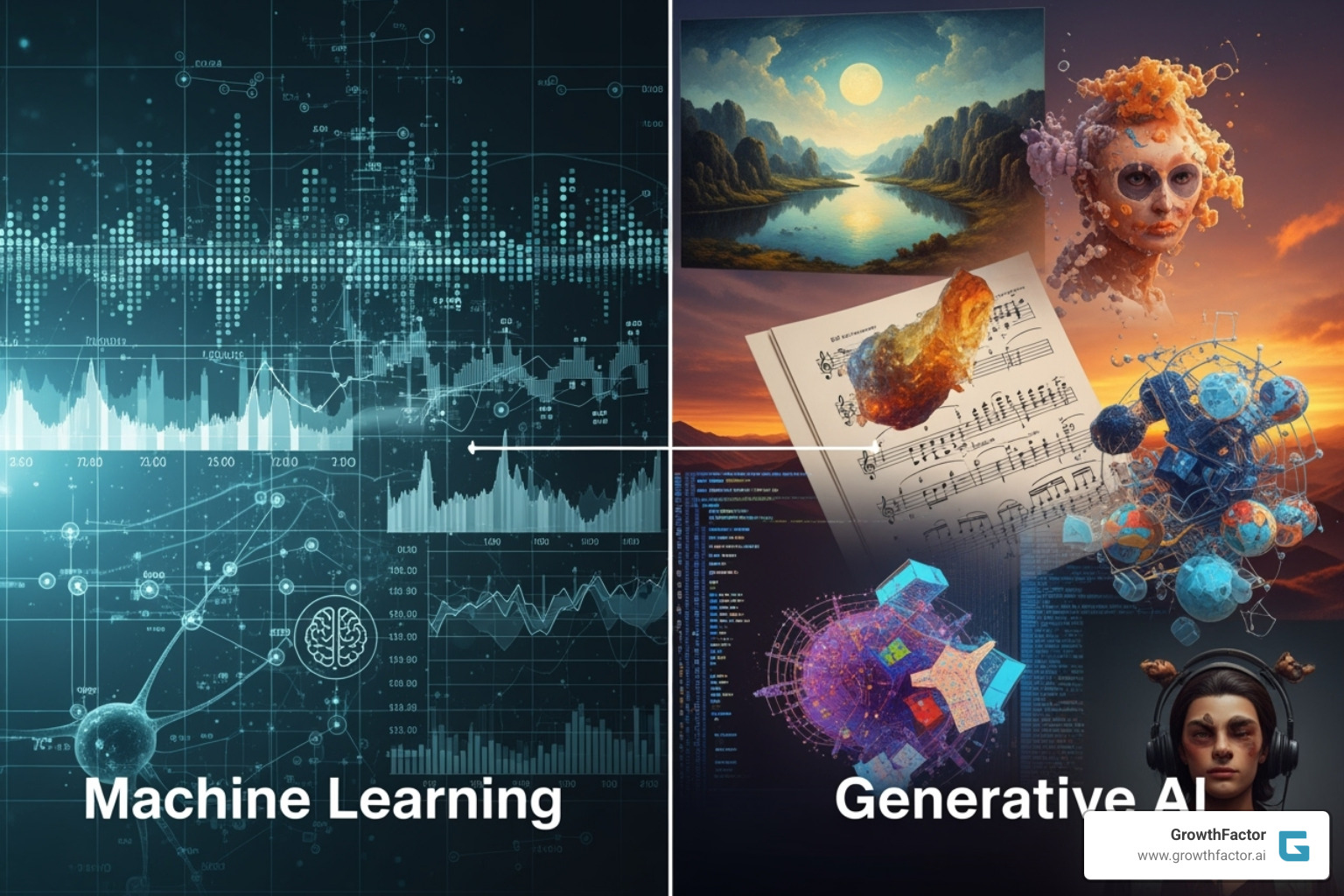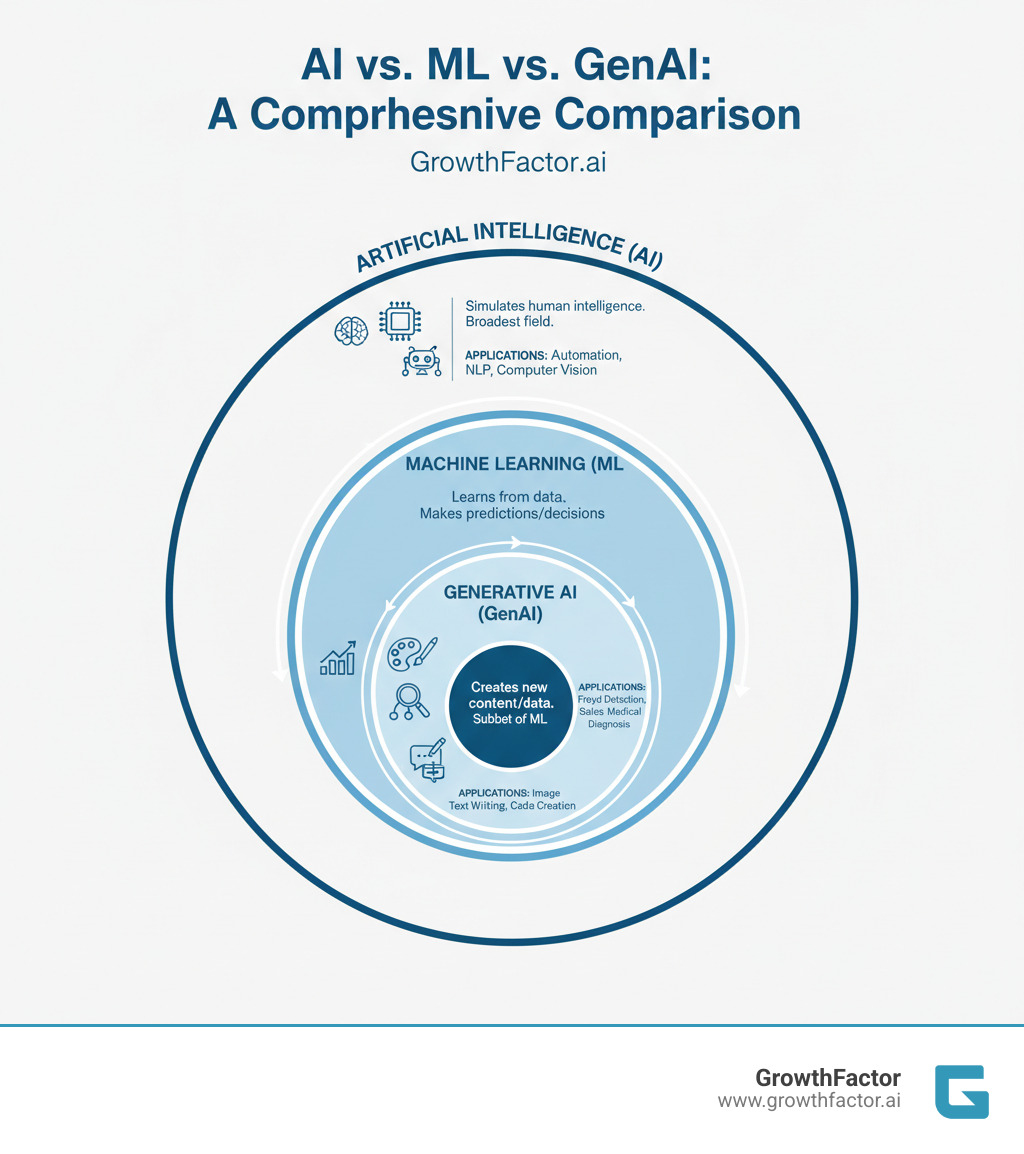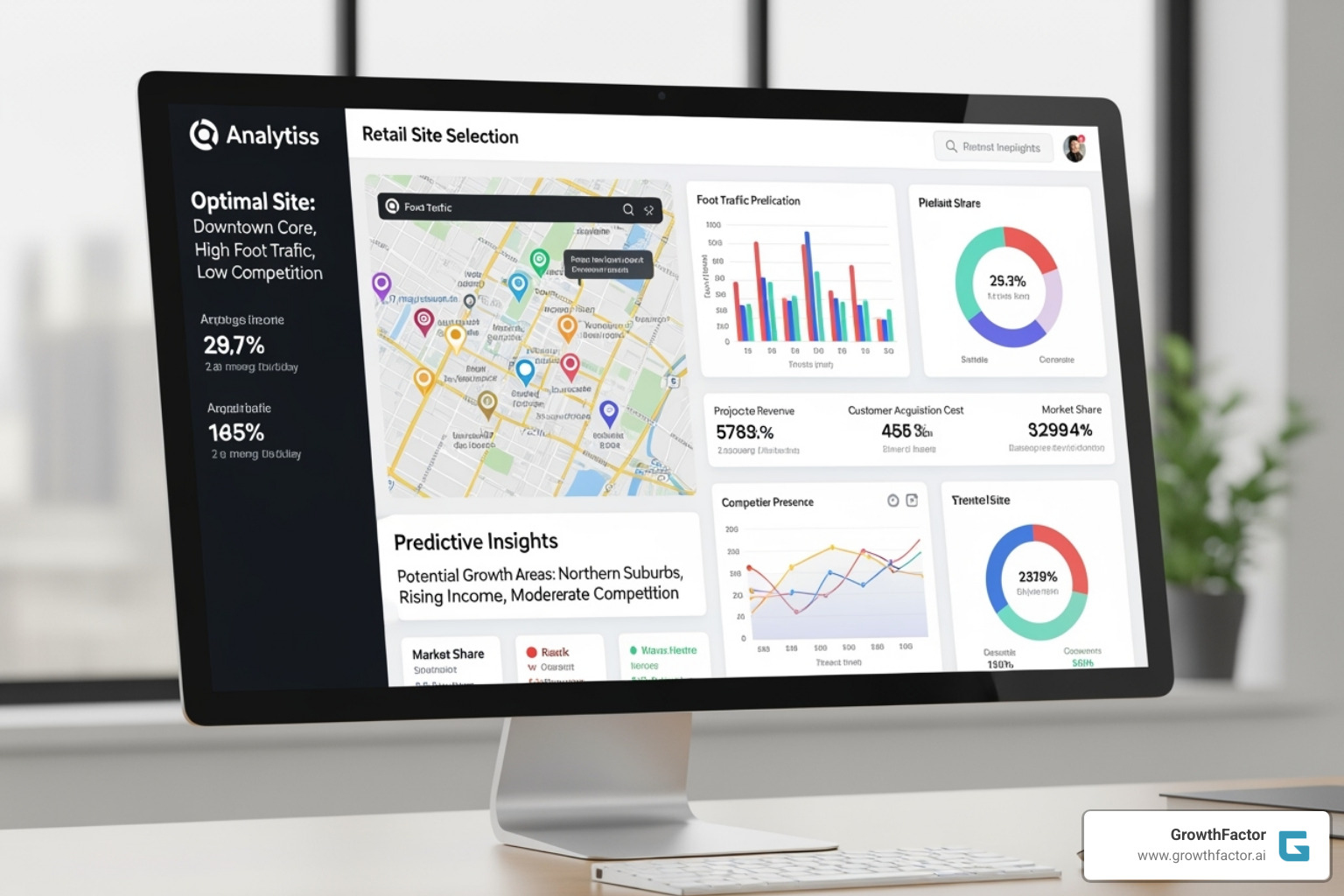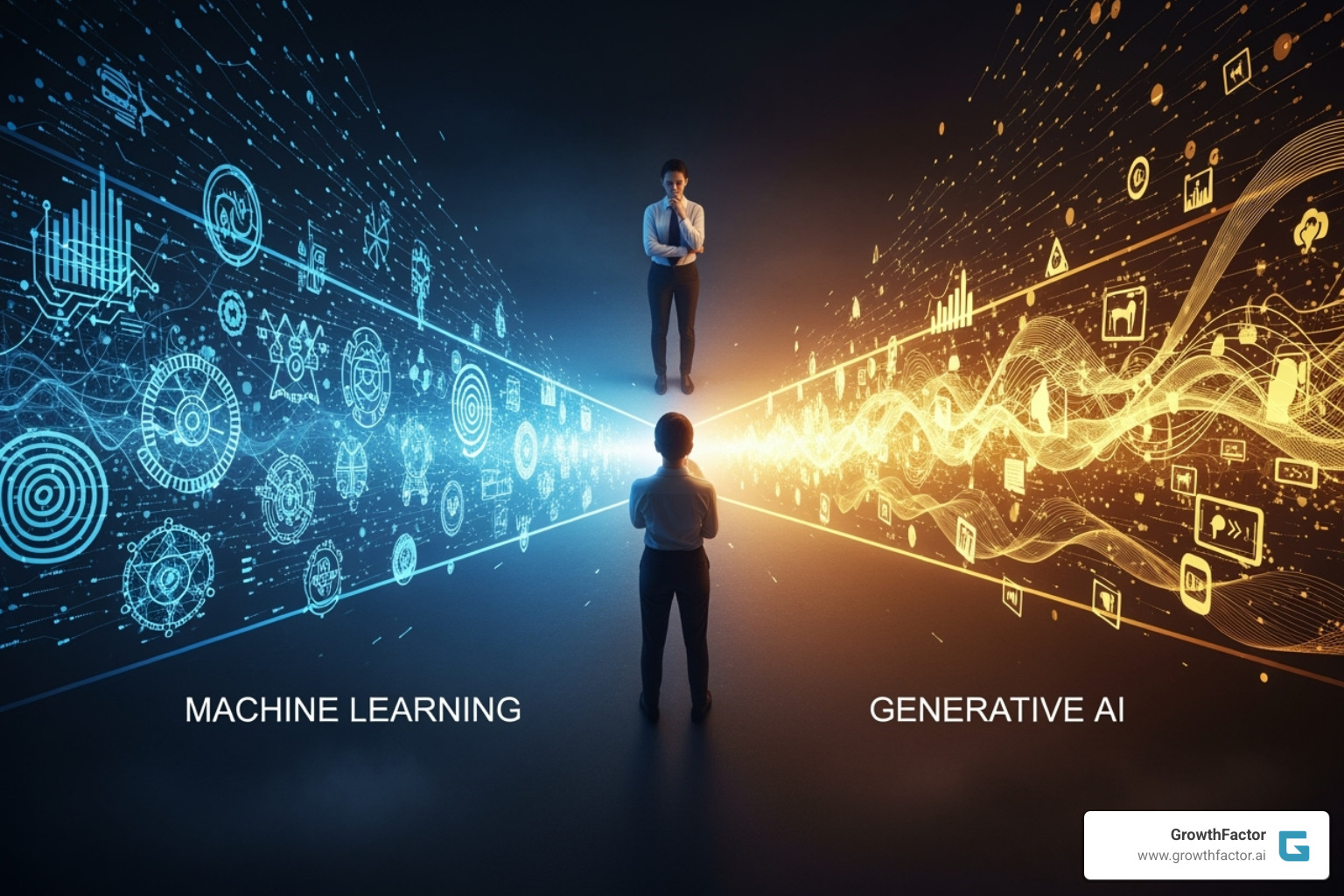The Ultimate Guide to Machine Learning vs Generative AI
Why Understanding Machine Learning vs Generative AI Matters for Business Leaders

Machine learning vs generative ai represents a critical technology distinction for business leaders. While both are types of artificial intelligence, they serve different purposes that can transform company operations.
Quick Answer:
- Machine Learning (ML): Analyzes existing data to make predictions and decisions.
- Generative AI (GenAI): Creates new, original content like text, images, and code.
- Key Difference: ML predicts from existing data; GenAI creates what doesn't yet exist.
- Relationship: GenAI is a specialized subset of machine learning.
- Best Practice: The most successful businesses use both technologies together.
The confusion is understandable. After ChatGPT's 2022 release, many organizations shifted focus to generative AI, creating uncertainty about when to use it versus traditional ML. The reality is simple: ML excels at analysis and prediction (like forecasting sales or detecting fraud), while GenAI shines at creation (like drafting marketing copy or new product designs).
In a 2024 survey, 64% of senior data leaders said generative AI has the potential to be the most transformative technology in a generation. Meanwhile, roles for AI and ML Engineers have increased 85% in recent years. Understanding both is essential for a competitive advantage.
I'm Clyde Christian Anderson, founder and CEO of GrowthFactor.ai. We've used both machine learning vs generative ai to help retail clients open up $1.6M in cash flow through smarter location decisions. My experience shows that the most powerful solutions strategically combine both approaches.

Quick look at machine learning vs generative ai:
Foundational Concepts: Understanding the AI Family
To understand machine learning vs generative ai, picture them as members of a family. Understanding their relationship helps clarify when to use each one.
- Artificial Intelligence (AI) is the broadest term, covering the entire vision of creating machines that can think and reason like humans.
- Machine Learning (ML) is a subset of AI that teaches computers to learn patterns from data without being explicitly programmed.
- Generative AI (GenAI) is a creative subset of ML that uses its learned knowledge to create entirely new content, like an artist who studies masterpieces to create original work.
In short: If AI is the brain, ML is the part that learns from experience, and GenAI is the creative corner that dreams up new ideas.
What is Machine Learning (ML)?
Machine Learning is essentially advanced pattern recognition. Its core mission is to spot patterns, make predictions, and classify information by learning from examples. As MIT's explanation of machine learning shows, algorithms improve through data exposure, not rigid programming.
ML uses three main learning approaches:
- Supervised learning: Learns from labeled data where the correct answer is provided, powering tools like email spam filters.
- Unsupervised learning: Finds hidden patterns in unlabeled data, useful for tasks like customer segmentation.
- Reinforcement learning: Learns through trial and error, receiving rewards for good choices, as seen in game-playing AI.
The consistent goal is to analyze data to make better decisions, turning raw information into actionable insights.
What is Generative AI (GenAI)?
Generative AI is the creative engine in the machine learning vs generative ai comparison. It learns the underlying patterns in data so deeply that it can create entirely new, authentic content.
GenAI works by understanding data distributions—the “recipe” behind different content types—and then generating new variations. Key technologies include:
- Large Language Models (LLMs): Systems like ChatGPT that digest massive text datasets to generate human-like responses.
- Generative Adversarial Networks (GANs): A pair of AI systems where one creates content and the other judges it, pushing both to improve and create realistic outputs.
- Transformers: The foundational architecture that excels at understanding context, enabling the generation of coherent and relevant content.
The primary goal shifts from analysis to the production of novel outputs. As explored in MIT's comprehensive guide to generative AI, GenAI is valuable for tasks requiring originality and rapid content production, complementing ML's analytical strengths.
The Core Distinctions: Machine Learning vs Generative AI
Understanding machine learning vs generative ai is simple when you focus on their purpose: one analyzes what exists, while the other creates what doesn't. If you need to find patterns in your data, use machine learning. If you need to generate something new, use generative AI.
| Feature | Machine Learning (ML) | Generative AI (GenAI) |
|---|---|---|
| Primary Goal | Analysis, prediction, classification, decision-making | Creation of new, original content or data |
| Typical Output | Predictions (e.g., a number), classifications (e.g., a label), insights, optimized actions | Text, images, audio, video, code, synthetic data |
| Learning Approach | Supervised, Unsupervised, Reinforcement Learning | Primarily Unsupervised or Self-Supervised Learning |
| Data Requirements | Often labeled, structured data for supervised tasks; can use unstructured for others | Massive, diverse, often unstructured datasets to learn distributions |
| Model Complexity | Wide spectrum, from simple statistical models to deep neural networks | Generally highly complex, often deep neural networks (Transformers, GANs) |
| Key Function | Discriminative (learns boundaries) | Generative (learns data distribution) |
| Analogy | Detective (finds patterns, makes judgments) | Artist (creates new works from inspiration) |
The key technical difference is discriminative versus generative models. ML models are typically discriminative, learning to distinguish between categories. GenAI models are generative, learning the actual distribution of data to create new samples.
Goal and Function: Prediction vs. Creation
The core mission separates the two. Machine learning acts as a detective, analyzing existing data to make predictions. For example, our AI-powered retail analytics platform uses ML to analyze market data and guide location decisions.
Generative AI is an artist, using its knowledge to create new content. For a new retail location, an ML model might predict its success, while a GenAI model could write the press release, design promotional materials, and create a virtual tour.
Outputs and Results: Analysis vs. Novelty
The results from machine learning vs generative ai are fundamentally different. Machine learning produces analytical outputs—a numerical prediction (e.g., 85% chance of success), a classification (e.g., high-risk customer), or data insights. These are concrete answers to specific business questions.
Generative AI creates novel content that didn't exist before, such as a compelling product description, a unique marketing image, or synthetic data for training other models. For instance, an ML model might predict a stock's rise, while a GenAI model could write a detailed market report explaining why.
Data Requirements and Learning Paradigms in machine learning vs generative ai
Data needs also differ significantly. Traditional ML often works best with structured, labeled data, like spreadsheets with clear categories and known outcomes. This is especially true for supervised learning.
Generative AI thrives on massive, unstructured datasets like entire libraries of text or millions of images. It learns the underlying patterns without needing pre-labeled answers, primarily using unsupervised or self-supervised learning.
This difference often dictates which technology to use. If you have clean, organized data and need specific predictions, ML is your best bet. If you have vast unstructured content and need to create something new, GenAI is the answer.
Real-World Applications: ML and GenAI in Action
The practical impact of machine learning vs generative ai is reshaping entire industries. The businesses winning today aren't just adopting AI—they're understanding exactly when to use each type to create real value. According to a DataAI Executive Leadership Survey, a majority of data leaders see GenAI as a potentially transformative technology.

Common Use Cases for Machine Learning
Machine learning shines when you need to predict, analyze, and optimize. It's a data-driven tool for making smarter business decisions.
- Predictive Analytics: In retail real estate, ML forecasts which neighborhoods will see the most foot traffic growth.
- Demand Forecasting: Retailers use ML to predict inventory needs, preventing overstocking and stockouts.
- Recommendation Engines: Services like Netflix and Amazon use ML to suggest content and products based on user behavior.
- Fraud Detection: Financial institutions rely on ML to spot suspicious transaction patterns in milliseconds.
- Real Estate Analysis: Our AI real estate market analysis platform processes demographics, traffic, and economic data to provide rapid insights. Similarly, ML makes property valuation more precise and streamlines complex decisions in AI real estate underwriting.
Common Use Cases for Generative AI
Generative AI excels at creation and innovation, acting as a tireless creative partner.
- Content Creation: Marketing teams generate blog posts, social media updates, and email campaigns at scale.
- Marketing Copy: GenAI crafts targeted product descriptions, ad headlines, and other copy with consistent tone and style.
- Software Development: Developers use GenAI to generate code snippets, translate between languages, and accelerate their workflow.
- Design and Engineering: For AI for property development, GenAI can rapidly generate architectural concepts optimized for different goals.
- Cost Reduction: MagellanTV provides a great example, slashing translation costs from $20 to $1 per minute using AI.
- Image and Video Synthesis: Businesses create marketing visuals, product mockups, and promotional videos without traditional production costs.
The real magic happens when businesses understand that machine learning vs generative ai isn't about choosing sides—it's about deploying the right tool for the job.
Choosing the Right Tool: Synergy, Strategy, and Challenges
Choosing between machine learning vs generative ai is about matching the tool to your business objective. You wouldn't use a microscope to paint a mural. Similarly, ML is for analyzing existing data, while GenAI is for creating something new. Often, the best solutions strategically combine both.

When to Choose Traditional ML over GenAI
Despite the hype around GenAI, traditional ML remains the backbone of many critical business applications.
- For high-stakes predictions: In areas with significant financial or safety risks, like medical diagnostics or risk assessment, the proven reliability of ML is essential.
- With domain-specific data: For specialized industries, fine-tuned ML models can provide more precise insights than a broad GenAI model.
- When interpretability is critical: In regulated fields like credit scoring, traditional ML models often provide clearer explanations for their decisions.
- Due to privacy concerns: With traditional ML, you maintain greater control over proprietary data, avoiding potential leaks associated with some public GenAI tools.
As one MIT researcher advises in this guide on when to use generative AI versus predictive AI, if you want to predict things based on domain-specific data, use traditional machine learning.
When to Choose GenAI over Traditional ML
Generative AI shines when creativity and content creation are the primary goals.
- For content generation: GenAI can produce high-quality marketing copy, blog posts, and product descriptions at unprecedented speed.
- For creative tasks: Design and engineering teams use it to brainstorm concepts, iterate on ideas, and explore novel solutions.
- With unstructured data: GenAI naturally handles text, images, and other unstructured formats, simplifying tasks like document processing.
- For rapid prototyping: Developers, designers, and marketers can use GenAI to create code snippets, mockups, and campaign materials in minutes.
In our AI-powered real estate work, we use GenAI to generate market reports and draft initial lease agreements, speeding up manual processes.
The Power of Synergy: Using ML and GenAI Together
The most innovative companies find that machine learning vs generative ai is not a versus situation. These technologies work best together.
- GenAI creates synthetic data to train ML models when real-world data is scarce or sensitive.
- ML identifies patterns that GenAI personalizes, allowing for customized marketing messages based on customer behavior.
- GenAI transforms complex ML outputs into clear narratives and visuals that business users can easily understand.
Our AI Location Intelligence platform exemplifies this synergy. ML algorithms predict location success, and then GenAI generates comprehensive reports explaining the findings.
Ethical Challenges and the Future of machine learning vs generative ai
Both technologies bring opportunities and responsibilities.
- Traditional ML faces challenges with data bias and model transparency. Learning from historical data can perpetuate past discrimination, and the "black box" nature of some models makes them hard to interpret. The field of Explainable AI (XAI) aims to address this.
- GenAI has unique challenges like "hallucinations" (plausible but false information), copyright concerns, and the potential for creating misinformation.
Despite these problems, the future is promising, with trends like AutoML, multimodal models, and agentic AI systems on the horizon. Addressing AI bias remains a priority across all AI development, requiring thoughtful implementation and human oversight.
Frequently Asked Questions about Machine Learning and Generative AI
The world of machine learning vs generative ai can seem complex, but the most common questions have straightforward answers.
Is Generative AI just a more advanced form of Machine Learning?
Yes, that's a good way to think about it. Generative AI is a specialized branch of machine learning that focuses on creation rather than just analysis. All GenAI is ML, but not all ML is GenAI.
GenAI builds on core ML principles but takes them a step further. It uses advanced architectures to understand data so deeply that it can generate new, authentic outputs, much like a chef uses basic techniques to create innovative dishes.
Can Generative AI replace traditional Machine Learning jobs?
GenAI isn't eliminating ML jobs; it's evolving them. It automates routine tasks, which frees up professionals to focus on higher-level strategy, model architecture, and ethical oversight. This shift has actually increased demand for engineers who are skilled in both types of AI, creating new opportunities rather than simply replacing existing roles. The key is to continuously learn and expand your toolkit.
Which is better for my business, ML or GenAI?
Neither is inherently better—they are designed for different purposes. The right choice depends entirely on your business goal.
- Choose traditional ML when you need to analyze existing data, make predictions, or optimize processes. It excels when you have a specific question and need a reliable, data-driven answer.
- Choose GenAI when you need to create new content or explore novel solutions. It shines when the goal is creation, such as writing marketing copy or designing product mockups.
The most successful businesses often use both together. For example, at GrowthFactor, we use ML to predict the best locations for a retail client and then use GenAI to create compelling reports that help them make confident decisions. Start with your business challenge to determine which technology—or combination of technologies—is right for you.
Conclusion: Navigating the AI Revolution for Business Growth
Understanding machine learning vs generative ai is about positioning your business for the future. These two AI powerhouses serve different but equally important roles.
- Machine Learning is your analytical backbone, predicting customer behavior and optimizing operations.
- Generative AI is your creative partner, producing content and generating new ideas at scale.
The real magic happens when you see them as collaborative tools, not competitors. The most successful businesses strategically combine both to create an best competitive advantage.
At GrowthFactor, our AI-improved platform demonstrates this synergy. We use machine learning to analyze market data and performance metrics, then layer in generative AI to create detailed reports and simulate scenarios. This combination helps our clients make smarter, faster decisions that improve their bottom line.
The businesses thriving today are not just using the most advanced technology—they're using the right technology for the right problems. When you need insights, lean on ML. When you need creativity, turn to GenAI. When you need both, that's where change happens.
Start with your goals, understand your data, and then choose the AI approach that will get you there most effectively.
Explore how our all-in-one real estate platform can revolutionize your retail expansion strategy and see how the strategic combination of ML and GenAI can transform your site selection process.
Citations
The human algorithm
Ready to see what we're cooking?
Submit your information below and we'll be in touch to schedule.








